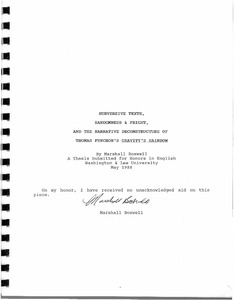| dc.rights.license | In Copyright | en_US |
| dc.creator | Boswell, James Marshall, Jr. | |
| dc.date.accessioned | 2023-04-21T19:30:15Z | |
| dc.date.available | 2023-04-21T19:30:15Z | |
| dc.date.created | 1988 | |
| dc.identifier | WLURG038_Boswell_thesis_1988 | |
| dc.identifier.uri | https://dspace.wlu.edu/handle/11021/36150 | |
| dc.description.abstract | Our inability to paraphrase and reconstruct this book's
11 story, 11 however, is not simply a product of its length and
complexity. Rather, the book is structured in such a way that it
makes this kind of coherent recall utterly impossible. When we
begin to understand how this book is designed and how Pynchon
expects us to read it, we also begin to key in on Pynchon's
primary thematic concerns. In effect, Pynchon "cons" us into
understanding his view of the world: we expect his book, an
American "novel" set in the second World War, to cohere in terms
of cause and effect interpretation, and we also expect the same
thing of our own lives; but Pynchon's work subverts this
tendency, as does the mad, sprawling, comic, and horrifying world
according to Thomas Pynchon.
How do we, then, approach this intimidating text? We will
divide our inquiry into three primary areas of interest, all of
which, when taken together, represent the compass coordinates of
Pynchon's text. First, we will look at Gravity's Rainbow's five-part plot structure; next, we will examine his view of language
and his use of a Derridian "absent center;" and lastly, we will
address Pynchon's subversion of cause and effect analysis and his
resultant view of history and fiction. All of this is done with
an understanding that this book is ultimately inexhaustable; with
Gravity's Rainbow, one must simply find an area or direction of
interest and be content for the time being with a mapping of that
terrain. If these three maps lead to further exploration, so much
the better. [From Introduction] | en_US |
| dc.format.extent | 75 pages | en_US |
| dc.language.iso | en_US | en_US |
| dc.rights | This material is made available for use in research, teaching, and private study, pursuant to U.S. Copyright law. The user assumes full responsibility for any use of the materials, including but not limited to, infringement of copyright and publication rights of reproduced materials. Any materials used should be fully credited with the source. | en_US |
| dc.rights.uri | http://rightsstatements.org/vocab/InC/1.0/ | en_US |
| dc.subject.other | Washington and Lee University -- Honors in English | en_US |
| dc.title | Subversive Texts, Randomness & Fright, and the Narrative Deconstructure of Thomas Pychon's Gravity's Rainbow | |
| dc.type | Text | en_US |
| dcterms.isPartOf | WLURG38 - Student Papers | |
| dc.rights.holder | Boswell, James Marshall, Jr. | |
| dc.subject.fast | Gravity's Rainbow (Pynchon, Thomas) | en_US |
| dc.subject.fast | American literature | en_US |
| local.department | English | en_US |
| local.scholarshiptype | Honors Thesis | en_US |
